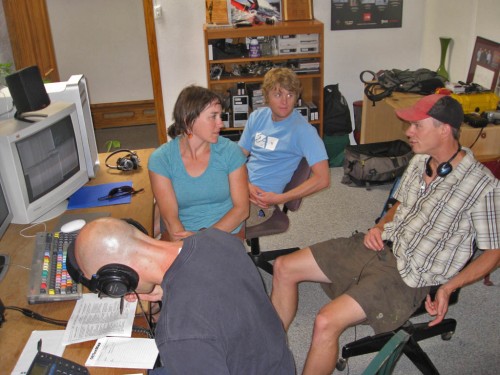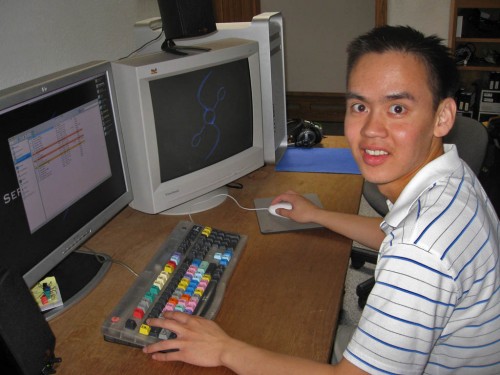Film School with Serac Adventure Films – Editing
Raw footage is to film as a tube of paint is to a painter – it helps to start with good quality, but the real artistry is how the paint or video is applied to the canvas/screen. In our case, we shot 2.5 hours of film and then spent 16 hours editing it. This seemed like a lot to me until Michael Brown mentioned it was typical to spend months editing a 45 minute film.
The editing process starts with labeling all of your tapes and transferring the individual clips into a computer. We were using Final Cut Pro, but the steps are the same for any software. First the footage is separated into scenes (interview, tree climb, etc) and within those scenes, the different camera are separated out onto different tracks. The end result is a timeline which looks like this: < < < < <. The advantage of this is that you can see all of your related footage at once and break it down into manageable chunks.

- Geekin’ out at the Serac Adventure Films headquarters. The modern-day editing room looks a lot like an office with computers in it.
The Additive Process
Filming expeditions or adventures is tough as you never really know what you are going to get. Instead of spending days culling the footage down to eight hours, then four, then two, etc., Serac Adventure Films starts with whatever the best moment on film was and then adds whatever it takes to get to and from that moment. This works for both the overall focus of the film as well as individual sequences.
The next step is to start cutting different angles together which makes the film much more visually interesting. For instance, in real life if a person points to a mountain, your eyes would follow his gesture to the peak and the scene would change. It’s the same in film making, but it has to be done in a logical way or it seems disjointed. This is where detail and second camera shots come in handy as they provide a logical change of scenery (feet walking, stream crossings, etc.) if you want to denote a long event in a short period of time. A video fade-through-black does the same thing (denotes a passage of time), but as Ryan pointed out, this is cheating and it is far better to cut together scenes. For instance, a long shot of someone reaching for a rock followed by a few seconds of hands-on-rock details, then back to the long shot makes five minute ascent flow naturally in a matter of seconds.
At this point, we were starting to split hairs, or more appropriately, frames. The price of Final Cut Pro’s editing power is that it takes a while to learn, not to mention how long it takes to learn the art of editing itself. In our case, the SAF crew kept things moving along with flying fingers whenever our editing ambitions overcame our technical skills, which was most of the time.

- SAF Editor Lam Nguyen’s blinding speed on Final Cut Pro made it look like he was playing Guitar Hero after a six-pack of Red Bull.
Once all of the separate scenes are done, they are assembled into an overall rough cut, which in turn is edited again for length and continuity between scenes. This is a reiterative process where little bits & pieces are trimmed, sound is balanced, over-dubbed voice tracks are added in and titles & credits are added. The finished result should hopefully look a lot like a movie…!
The Serac Adventure Films school is excellent and highly recommended. At times, expeditions can be tedious and boring, but after taking the class, hopefully my films will not be. As much as anything, the class gave me a greater appreciation for the art of film making and I swear I’ll never use a video cross-fade again (maybe).
A cross-fade free clip from the “Heart of Stone” International début…
________________________________
Help support StraightChuter.com and get 15% off on a V.I.O POV.1 Camera Pakage from Backcountry.com! Click the photo below…
Category: Trip Reports










Andrew,
It is interesting to see how technical “film” making has gotten.
The other day Dick Barrymore (ski film maker in the late 60’s early 70’s) died.
Looking at his book “Breaking Even,” he said that he simple read a Kodak simple short brosure that came with the camera, and that’s how he made his films.
I would suggest Dick’s book as a good read, if you are interested in ski history and ski film making.
Halsted
I love the title – “Breaking Even.” It sounds like a good book and great time to read it. Dick was a little ahead of my time (I went to Warren Miller films religiously for years), but I’ve often heard other ski film makers credit Dick for his inspiration.